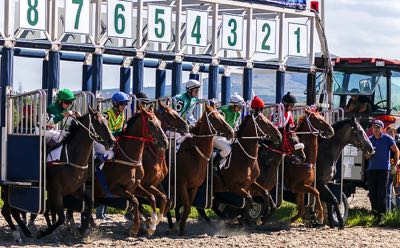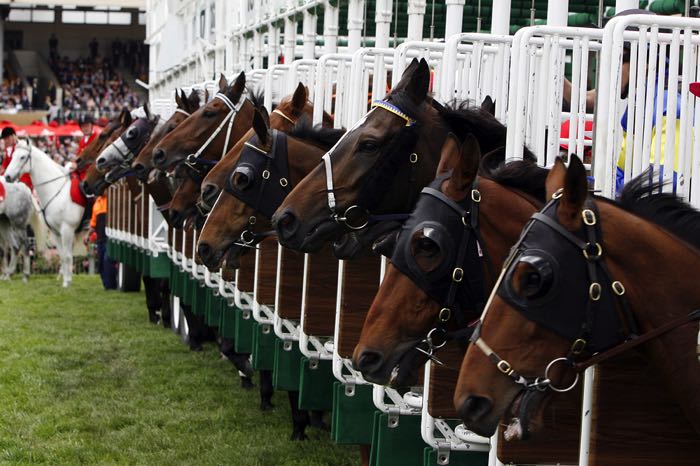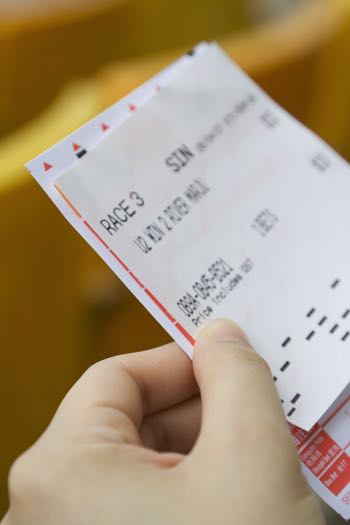
mikle / Bigstockphoto.com
Part of the excitement generated by the wonderful sport of horse racing lies in the build-up to the race itself. Having done all of your rigorous form study (or picked your favourite colours) and placed your bets, all that remains now is to watch your noble steed head down to the start, line up… and they’re off! Except sometimes they aren’t. A thorn in the side of many a sporting discipline, horse racing is by no means immune to the perils of the false start.
A hazard in any event where humans or beasts are required to act exactly on cue, false starts are all but impossible to avoid entirely. The manner in which they occur does of course differ according to the sport in question, as does the punishment dished out to the offenders. The NFL and Formula 1 for example penalise those who go too soon with yardage and time penalties, whilst athletics is harsher still – one false start on the track and you are disqualified. It does seem a little unfair that in an event such as the Olympics, four years of hard work can go up in smoke due to a split-second miscalculation, but it seems those athletics officials are not to be trifled with.
As we shall see, horse racing’s disciplinarians aren’t anything like so penal in their treatment of those who are perhaps a little too keen to get proceedings underway. But what exactly does a false start in horse racing look like? How are they assessed? And what happens when they occur?
More Than One Way to Start a Race
In comparison to athletics, in which starts are assessed using pressure or motion pads built into the starting blocks – with the measured reaction times then being compared with the average response speed of the human brain – the determination of false starts in horse racing isn’t anything like so scientific.
Part of the reason for this is of course that it doesn’t need to be. In a 100m athletics race, getting out of the blocks a millisecond ahead of your rivals may well be the difference between winning and losing, but such small margins rarely come into play in horse racing – particularly not in the jumps racing sphere.
The start is admittedly more critical in flat racing, and the sport deals with this disparity by employing two vastly different starting methods in each sphere. Given these alternative systems and their varying levels of susceptibility to false starts, it therefore makes sense to separate the disciplines of flat and jumps racing when taking a closer look at the false start phenomena.
Racing on the Level: An Even Break

As mentioned, it is relatively important in flat racing that the field gets off to an even start – or is at least given the chance to do so – and especially in the shorter sprint races. And the universal apparatus employed to achieve this result is that of the starting stalls. Able to be opened at both the front and the back, each runner is loaded into their assigned stall prior to the race beginning, with the front of the stall remaining closed. Only when all runners have been successfully loaded will the start official give the signal for the race to begin. And it is at this point that all stalls open in unison, and the runners spring forth to begin the race.
Of course, exactly how quickly the horse emerges from the stalls will depend upon their natural inclination, with the tactical instructions given to the jockeys also playing a role. As far as beginning a horse race goes though, it is difficult to think of a fairer method, and it is no surprise that the starting stalls have become a part of the furniture at flat tracks all around the world.
Given this starting method, the obvious question to ask is how can a false start occur in the first place, with the front of the stalls remaining closed until the starter gives the signal? And it certainly isn’t easy for a runner to emerge from its allocated berth before their stall opens. Not easy, but not impossible.
Sturdy as they may be, the stalls are no match for a one-tonne animal should it set its mind on bursting the gates apart. Also, the fact that the closing section covers only the top half of the stall – leaving the area around the horses’ legs clear – enables a particularly intrepid equine escape artist to duck under the closed section and run free, with predictably unfortunate consequences for the jockey. And then of course we have the instance of mechanical failure, where not all of the stalls open in unison. This is the rarest of the three scenarios mentioned, but not unheard of.
Thankfully, instances of runners bursting through the front of the stalls, or ducking out underneath them are relatively scarce. But what happens when they do occur? Unlike in athletics, where the guilty parties are automatically disqualified, under the rules of racing false starters are still allowed to take part in the race. In reality, however, this hardly ever occurs, as any animal escaping the stalls in such a manner is unlikely to be in the right frame of mind to take part in the race. There is also the additional issue of it not always being possible to catch a false starter immediately, with such horses regularly completing a large part of the course before being brought under control. A combination of that frame of mind and wasted energy means that should a runner false start on the flat, they will almost always be withdrawn.
But what about the rest of the field? Some of whom will likely have been waiting patiently in their stalls at the moment the rebellious nag made their break for freedom. Due to the disruption caused, and the additional time taken to recapture the false starter, all runners will be taken out of the stalls in the event of a false start. Only when the runaway is safely off the track – or back at the start if still taking part in the race – will the reloading process begin once more.
False Starts in Jumps Racing
With contests being held over minimum distances of two miles and all the way up to four miles and more, it isn’t anything like so crucial that runners get off to an even break in National Hunt racing – particularly as races are regularly tactically run affairs, as opposed to the full-throttle nature of a five-furlong sprint contest for example. And with that in mind, the use of starting stalls in the realm of jumps racing would seem a little unnecessary. But if not via the use of this starting apparatus, how do jumps races begin?
Unlike the opening and closing contraptions of the flat, all that is needed over the jumps is a simple piece of string. Spread across the track, the field are asked to approach this length of string or tape in an organised manner, with the starter giving the signal to advance by raising his flag. Once satisfied the runners are walking in a relatively evenly manner towards the start, the starter will then lower his flag, giving the signal for the string or tape to be removed and for the race to begin. If unhappy with the manner in which the runners are approaching the start, the official will ask the field to take a turn and approach in a more organised manner.
This all sounds relatively straightforward in theory, but in comparison with the flat this method of starting does place a far greater emphasis upon the skills of the jockeys. Convincing one horse to approach the start in a sensible manner can prove problematic. Persuading a field containing 20 or more runners to do so in unison, can certainly prove challenging to say the least.
Given this looser starting method, it shouldn’t come as the biggest surprise to learn that false starts are far more common in jumps racing than they are on the flat. They are nothing like so dramatic as the stalls-bursting efforts on the level, however. A false start over jumps simply occurs when one or more of the field begins racing and breaks the starting string/tape before the starter has given the signal for the race to commence. Unlike on the flat, the majority of false starters can be pulled up relatively quickly and taken back to the start to take part at the beginning of the race the second time around.
This second time around start will however differ markedly from the first effort. Having initially failed to organise themselves sufficiently to walk in towards the start, for their second effort the field must line up side by side spread across the track, with their noses almost on the starting tape. Once in position, the starter will then lower his flag and the race will begin from a standing start. This is not an ideal scenario, but it is one that does at least avoid multiple false starts, which had become an issue before this standing start rule was introduced in 2014.
How Do False Starts Effect Your Bet?
 A false start will only affect your bet if it results in a horse being withdrawn from the race. If it is the horse you have backed that is withdrawn, you will receive your stake back, as the horse will be deemed a non-runner. In the instance that it is one of the other runners withdrawn, you can expect a Rule 4 deduction to be enforced – a Rule 4 being a deduction applied to all winning bets, with the amount taken being directly related to the price of the withdrawn runner.
A false start will only affect your bet if it results in a horse being withdrawn from the race. If it is the horse you have backed that is withdrawn, you will receive your stake back, as the horse will be deemed a non-runner. In the instance that it is one of the other runners withdrawn, you can expect a Rule 4 deduction to be enforced – a Rule 4 being a deduction applied to all winning bets, with the amount taken being directly related to the price of the withdrawn runner.
One final thing to remember here is that a false start is not the same as a refusal to start. If your selection is either lined up at the start or is in the starting stalls when the starter gives the signal for the race to begin, it will be deemed to have taken part in the race. A statement that applies whether your runner bolts into the lead or stands stock still as the rest of the field sets off towards the finish line. Such reluctant racers will be settled as losers, with no stakes being returned.
Famous False Starts: The Race That Never Was
As troublesome as beginning a race can be, particularly in National Hunt racing, the race officials and jockeys do have plenty of practice at getting it right, with 1,000’s of races being held in the UK each year. And in fairness to all involved, the vast majority of the time races do begin without a hitch, even if a standing start may occasionally be required. But, despite these best-laid plans, procedures and practice, things can still go wrong – and back in 1993, it all went very wrong indeed! To conclude this article, we will take a look back at the most infamous false start incident in the history of the sport.
If you are going to experience a false start disaster, there is never really a good time to have it. There are however occasions that are considerably worse than others. And topping the list of nightmare scenarios for race officials is presiding over a false start catastrophe in the biggest jumps race of them all: the Grand National.
The 1993 Grand National
Unfortunately, that is exactly the scenario that unfolded in what was the 147th edition of the Grand National in 1993. An excellent tally in the sport of snooker, 147 proved not to be quite so worthy of celebration when it came to the world’s greatest jumps race.
Presiding over his final Grand National before retirement, any hopes 1993 race starter Keith Brown had of sailing serenely into the sunset were dashed in fairly spectacular style. The first attempt at starting the race come unstuck due to several riders becoming tangled in the tape. There was no need to panic however and Brown simply waved his red flag to recall those who had set off. With the signal being repeated by assistant Ken Evans located further down the track, those who had avoided the entanglement simply returned to the start. Danger averted? Not quite.
It was on the second attempt that the debacle blossomed fully. Remembering that this incident occurred in the days before the standing start method, the jockeys again walked in towards the line, and once again they became entangled. Try as he might though, Brown could not get the red recall flag to unfurl, no matter how frantically he waved. Assistant Evans, therefore, did not receive the signal to alert the runners who had set off, with the result being that 30 horses proceeded to jump the first fence, as nine others looked on from the start.
Indeed, it took until the final fence on the second circuit before some of the riders realised what had unfolded and pulled up their mounts. Not all though, as 14 continued on their pursuit of Grand National Glory. Esha Ness ultimately crossed the line in front, in the second-fastest time in the history of the race. Clock-busting time or not, the joy was short-lived for connections of the Jenny Pitman-trained runner, as the race was predictably declared void for the one and only time in its history – going down in infamy as “The Race That Never Was”.
